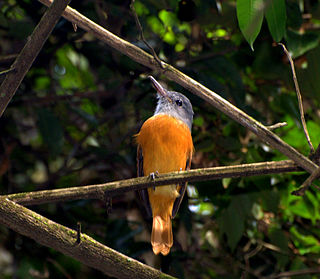
The guira cuckoo, known in Spanish as the pirincho is a species of gregarious bird found widely in open and semi-open habitats of northeastern, eastern and southern Brazil, Uruguay, Paraguay, Bolivia, and northeastern Argentina. It is the only species placed in the genus Guira.

Leptoptilos is a genus of very large tropical storks, commonly known as adjutants. The name means thin (lepto) feather (ptilos). Two species are resident breeders in southern Asia, and the marabou stork is found in Sub-Saharan Africa.

Phylidonyris is a genus of birds in the honeyeater family that are endemic to Australia.

The Kerguelen petrel is a small slate-grey seabird in the family Procellariidae. It is the only species placed in the genus Aphrodroma. It is a pelagic, circumpolar seabird of the Southern Ocean. It breeds on islands in the southern Atlantic and Indian Oceans.

Attila is a genus of tropical passerine birds, the attilas. They belong to the tyrant flycatcher family. The species in this genus have large heads and hooked bills; they are markedly predatory and aggressive for their size – hence the scientific and common names, which refer to Attila the Hun.

Embernagra is a genus of South American finch-like birds in the tanager family Thraupidae.

Vini is a genus of birds in the family Psittaculidae that are endemic to the islands of the tropical Pacific. There are eleven extant species of these small lorikeets ranging from the Bismark Archipelago through Fiji, Samoa, French Polynesia, and as far east as Henderson Island. All members of the genus have exceptional bright plumage, particularly the unusual all over blues of the blue lorikeet and the ultramarine lorikeet.

The Sunda brush cuckoo is a species of cuckoo in the family Cuculidae. It is found in Indonesia, Malaysia, the Philippines, Singapore, and Thailand. Its natural habitat is subtropical or tropical moist lowland forests. It was formerly treated as conspecific with the Sulawesi brush cuckoo with the English name "rusty-breasted cuckoo".

Horsfield's bronze cuckoo is a small cuckoo in the family Cuculidae. Its size averages 22g and is distinguished by its green and bronze iridescent colouring on its back and incomplete brown barring from neck to tail. Horsfield's bronze cuckoo can be destiguished from other bronze cuckoos by its white eyebrow and brown eye stripe. The Horsfield's bronze cuckoo is common throughout Australia preferring the drier open woodlands away from forested areas. This species was formerly placed in the genus Chrysococcyx.

Chrysococcyx is a genus of cuckoos in the family Cuculidae.
The pied bronze cuckoo is a species of cuckoo in the family Cuculidae. It is found on the Tayandu Islands, the Kai Islands and the Tanimbar Islands, all of which are part of the Maluku Islands in Southeast Asia. It was formerly treated as conspecific with the little bronze cuckoo.

The shining bronze cuckoo is a species of cuckoo in the family Cuculidae, found in Australia, Indonesia, New Caledonia, New Zealand, Papua New Guinea, Solomon Islands, and Vanuatu. It was formerly placed in the genus Chrysococcyx.

The white-eared bronze cuckoo is a species of cuckoo in the family Cuculidae. It was formerly placed in the genus Chrysococcyx. It is found in New Guinea.

The little bronze cuckoo is a species of cuckoo in the family Cuculidae. It was formerly placed in the genus Chrysococcyx. It is a common brood parasite of birds form the genus Geryone. This cuckoo is found in Southeast Asia, New Guinea and some parts of Australia, where its natural habitat is subtropical or tropical moist lowland forest. It is the world's smallest cuckoo. The pied bronze cuckoo was formerly considered to be a subspecies. Other common names for the little bronze cuckoo include the red-eyed bronze cuckoo and the malay green cuckoo. It has 11 subspecies which are generally recognized.

The black-eared cuckoo is a species of cuckoo in the family Cuculidae. Found across Australia, it migrates to eastern Indonesia and southern New Guinea. They are usually observed by themselves or in a pair as they don't raise their own young, rather they leave eggs in another species nest to be raised by host. This species was formerly placed in the genus Chrysococcyx.

The rufous-throated bronze cuckoo is a species of cuckoo in the family Cuculidae. It was formerly placed in the genus Chrysococcyx. It is found in the highlands of New Guinea where its natural habitat is tropical moist montane forests.

Ketupa is a genus of owls in the family Strigidae. The genus formerly contained just three species, the fish owls but based on the results from a genetic study published in 2020, the generic boundaries were altered. The genus now contains twelve species, nine of which were formerly placed in the genus Bubo.

Todirostrum is a genus of Neotropical birds in the New World flycatcher family Tyrannidae.

Gracupica is a genus of Asian birds in the family Sturnidae. It is sometimes merged with Sturnus or Sturnia.

Pitohui is a genus of birds endemic to New Guinea. The birds formerly lumped together as pitohuis were found by a 2008 study that examined their evolutionary history on the basis of the genetic sequences to have included birds that were quite unrelated to each other. They have since been separated into other genera.





















